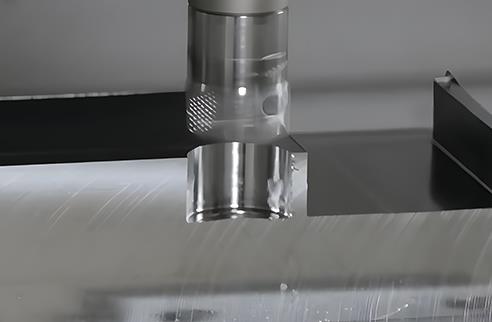CNC Plunge Milling, also known as Z-axis milling, is a highly effective machining technique where the cutting tool moves vertically along the Z-axis to engage with the material. Unlike conventional milling, which uses side cutting edges, plunge milling primarily relies on the end cutting edges of the tool to remove material in a drilling-like motion combined with translation along the X-Y plane. This unique approach makes plunge milling ideal for high-volume material removal, particularly when machining difficult materials, deep cavities, or parts requiring long tool overhangs.
Core Advantages: Solving Traditional Machining Challenges
1. Dramatically Improved Efficiency
CNC plunge milling significantly boosts machining efficiency, reducing machining time by up to 50% to 75% when removing large volumes of metal. This results in cost savings and faster production turnaround, a key benefit for industries requiring high-speed machining.
Example:
When machining 40Cr steel (55-60 HRC) with deep holes (Ø8.2mm × 50mm depth), traditional milling took 3 hours, while plunge milling completed the job in just 1 hour—a 200% improvement in efficiency.
2. Radially Reduced Cutting Forces
One of the biggest challenges in traditional milling is the high radial cutting forces, which can cause deformation in thin-walled parts or reduce tool life. Plunge milling reduces these forces by over 70%, leading to:
- Workpiece Deformation Control: Thin-walled and low-rigidity parts can be machined without risk of deformation.
- Older Equipment Stability: Even older or worn spindle machines can maintain stable performance, extending machine life and reducing the need for expensive equipment upgrades.
3. Exceptional Deep Cavity Capability
Plunge milling enables machining of deep cavities up to 250mm in depth without tool chatter or deflection, solving issues of tool vibration and breakage that occur in traditional deep cavity machining.
Benefit:
This capability reduces setup changes by over 50% in deep grooves, mold cavities, and aerospace components, offering considerable time and cost savings in industries with complex part designs.
4. Flexibility for Complex Geometries
Through multi-axis interpolation, plunge milling can machine hard-to-reach areas such as turbine blade root profiles. The process also supports both upward and downward cutting, providing flexibility in machining parts with special geometries.

Key Technical Details: Tools and Parameters
1. Specialized Tool Design
- Cutting Angles: Tools designed with an 87° or 90° angle optimize entry performance for plunge milling.
- Cooling Systems: Standard tools feature internal coolant channels to maintain consistent temperatures during machining, critical for maintaining tool life and cutting performance.
- Modular Inserts: Inserts are configurable based on the tool diameter, ranging from 2 inserts for Ø20mm tools to 8 inserts for Ø125mm tools.
2. Key Machining Parameters
- Feed Rate: 0.08-0.25 mm/tooth, depending on the material being machined.
- Cutting Depth: Typically 1.5 to 2 times the tool diameter for roughing operations.
- Stepover: Generally 60%-80% of the tool diameter to balance material removal rate and tool wear.
Material-Specific Applications: Industry Solutions
1. Superalloys: Aerospace Engine Components
- Challenges: Nickel-based alloys like Inconel 718 are known for high strength retention at elevated temperatures and work-hardening tendencies, leading to severe tool wear in traditional milling.
- Plunge Milling Application: Used for machining turbine blade fir-tree root profiles:
- Cutting Temperature Control: Internal coolant directly targets heat zones, preventing overheating.
- Tool Life Extension: Predominantly axial forces reduce cutting edge chipping.
- Distortion Control: No deformation in thin-walled blade sections.
- Parameter Guidance: Use small stepover (40% diameter), low feed (0.1mm/tooth) with high-pressure coolant (>80bar).
2. Titanium Alloys: Aerospace Structural Components
- Challenges: Ti-6Al-4V, a commonly used titanium alloy, exhibits low thermal conductivity and high chemical reactivity with tool coatings, complicating machining.
- Plunge Milling Benefits:
- Single-pass deep cavity machining reduces tool changes, improving productivity.
- Heat is evacuated with chips instead of transferring to the tool.
- 40% lower power requirement compared to helical milling, making it suitable for older machines.
Applications: Machining deep cavities in aircraft structural parts and landing gear blocks.
3. Hardened Steels: Mold Manufacturing
- Materials: 40Cr (55-60 HRC), H13 tool steel (48-52 HRC).
- Challenges: Traditional milling methods for hardened steels require 50 passes to machine 50mm depths, leading to low efficiency and excessive tool wear.
- Plunge Milling Performance Comparison:
- Traditional Milling: 50 passes, 3 hours, significant tool wear.
- Plunge Milling: 2 plunges + 5 finishing passes, 1-hour completion, 60% lower tooling costs.
- Critical Benefit: Reduces radial forces, ensuring the perpendicularity of cavities and minimizing tool deflection.
Practical Implementation Guide
1. When to Choose Plunge Milling
- Material Factors: Ideal for difficult-to-machine materials such as superalloys, titanium alloys, and hardened steels.
- Feature Geometry: Perfect for deep cavities (> 3× tool diameter), narrow slots, and complex surfaces.
- Equipment Conditions: Suitable for older or lower-power machines (<40-taper machines).
- Production Needs: Ideal for rapid prototyping and heavy roughing operations.
2. Implementation Strategy
Tool Selection: Prioritize 87° dedicated plunge mills with matched internal coolant channels.
Toolpath Programming: Utilize advanced CAM software (e.g., Hypermill, Mastercam) that supports multi-Z deep cavity optimization.
Parameter Optimization:
| Material Type | Feed (mm/tooth) | Stepover (% diam) | Cooling Method |
|---|---|---|---|
| Superalloys | 0.08-0.12 | 30-40 | High-pressure >80bar |
| Titanium alloys | 0.10-0.18 | 50-60 | Internal + air |
| Hardened steels | 0.12-0.20 | 40-50 | Oil mist |
Avoid Pitfalls: Finish machining should still be done with conventional milling; plunge milling is primarily used for roughing and semi-finishing.
While not a one-size-fits-all solution, CNC plunge milling is a transformative machining method for difficult materials, deep cavities, and parts requiring high rigidity. It is particularly advantageous in industries such as aerospace, energy, and mold manufacturing, where precision and material challenges are paramount. As CAM software improves its capabilities to handle multi-Z-axis code processing, CNC plunge milling continues to offer significant productivity and cost advantages. Manufacturers facing bottlenecks, aging equipment, or exotic material challenges should consider mastering plunge milling to remain competitive in the global market.



